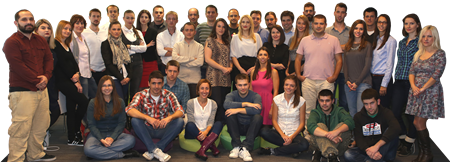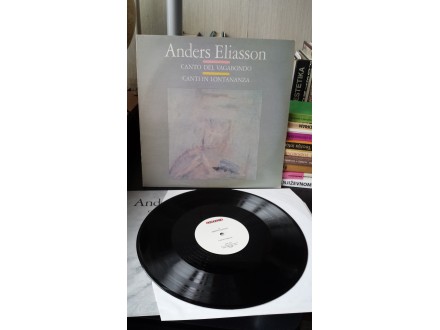Anders Eliasson - Canto Del Vagabondo / Canti in Lontan
| Cena: |
| Želi ovaj predmet: | 1 |
| Stanje: | Polovan bez oštećenja |
| Garancija: | Ne |
| Isporuka: | BEX Pošta Post Express Lično preuzimanje |
| Plaćanje: | Tekući račun (pre slanja) Ostalo (pre slanja) Pouzećem Lično |
| Grad: |
Novi Sad, Novi Sad |
Izdavač: Ostalo
Godina izdanja: 1988
Žanr: Klasična muzika
Tip: LP
Poreklo: Strani izvođač
RETKO!!!
made in Sweden 1988
inspirisano Karl Lineom i švedskim pesnikom Bengt Emil Jonsonom
Anders Erik Birger Eliasson (3 April 1947[1] – 20 May 2013[2]) was a Swedish composer.
Eliasson was born in Borlänge. His `earliest musical experiences originated from within myself: they were my own singing, and familiar tunes I heard on the radio. No classical music.` Marching his toy soldiers up and down, he used to imagine sounds, learning only later to describe them as an orchestra. Aged 9, he began the trumpet, started up a small jazz orchestra (two clarinets, trombone, rhythm section, guitar, trumpet), and aged 10 he was writing arrangements. A jazz bass-player, `an unbelievable musician`, taught him chords. Aged 14, he went to an organist, Uno Sandén, to learn harmony and counterpoint.[3]
Aged 16 he went for private study in Stockholm to `the wonderful Valdemar Söderholm`, who `confronted me once more with real music` – music such as he had first heard aged about 12. `The first real piece of music` which Eliasson heard `on a gramophone record was Haydn’s Symphony No. 104.`[4]
Under Söderholm, he studied counterpoint: there followed five years’ intensive work on Palestrina, Orlando di Lasso and above all Johann Sebastian Bach,[5] `the highest form of energy with which it’s possible to come into contact.`[6]
From 1966 he was a student under Ingvar Lidholm at the Royal Swedish Academy of Music, and until 1973 a member of the artistic committee of the Electronic Music Foundation, Stockholm. His first major successes were a choral work, Canto del vagabondo (1979), and his First Symphony (1989), for whose `originality, authenticity and musical clarity` Eliasson was awarded the Nordic Council Music Prize.
In 1991 he was composer in residence at the Lapland Festival in Arjeplog and visiting professor at Sibelius Academy Helsinki in the academic year 1993/94. 37 works of Eliasson´s were performed at the `1996 International Composer´s Festival Stockholm`.[7]
From 2000 Eliasson had performed a monodrama for soprano and 27 instrumentalists (Karolinas sömn / Karolina´s Sleep, premiered in 2012), a great number of chamber music as well as five large-scale concertos: a Concerto for Trombone and Orchestra (written for Christian Lindberg), a Concerto for Alto Saxophone and String Orchestra (for John-Edward Kelly, the dedicatee of Eliasson´s 3rd Symphony), a Double Concerto for Violin, Piano and Orchestra (for Roland Pöntinen and Ulf Wallin), a Double Concerto for Violin, Viola and Chamber Orchestra as well as a Concerto for Violin and Orchestra (Solitary Journey, original title in German, Einsame Fahrt).
Together with the composers Kalevi Aho, who was chairman of the jury, and Magnus Lindberg, Eliasson was juror in the 2nd International Uuno Klami Composer Competition 2008/09.[8]
From 2005 until his death, Anders Eliasson was composer-in-residence of the New York-based Arcos Chamber Ensemble.[9] He died in Stockholm, aged 66.
`The International Anders Eliasson Society` was registered on 7 March 2016 in Vienna; its inaugural meeting took place on 11 March 2016 at Stockholm´s Konserthuset.
Eliasson became familiar with classical and modernist aesthetics while still a student. `I was initially happy to be allowed to be a student in the proper way. But when I compared what was then fashionable to the classical period, the latter seemed so much better!` When he was accepted for Ingvar Lidholm’s composition class, he was, he says, shocked, because `when I came into contact with luminaries such as Karl [sic!] Karkoschka (actually Erhard Karkoschka) or Roman Haubenstock-Ramati – who were delightful people – I suddenly lost all contact with the music I had inside myself.` At that time, Stockholm was `a modernist fortress: dodecaphony, serialism, aleatoric music, musique concrète – there was every technique and trend and fashion. György Ligeti, John Cage and Terry Riley all taught in Stockholm. It was no big deal to master all that – it was only a question of techniques, not of music, nothing about it was authentic. [....] It was a time of unbearable self-denial. Metrical rhythms, melodies, even particular intervals were all taboo in contemporary music. This was a catastrophe for the human voice and the human ear – was then, and still is.` Anyone stepping out of line, he said, was immediately banished. He mentioned an example from Sweden, Allan Pettersson.
International shipping
Paypal only
(Države Balkana: Uplata može i preko pošte ili Western Union-a)
1 euro = 117.5 din
For international buyers please see instructions below:
To buy an item: Click on the red button KUPI ODMAH
Količina: 1 / Isporuka: Pošta / Plaćanje: Tekući račun
To confirm the purchase click on the orange button: Potvrdi kupovinu (After that we will send our paypal details)
To message us for more information: Click on the blue button POŠALJI PORUKU
To see overview of all our items: Click on Svi predmeti člana
Ako je aktivirana opcija besplatna dostava, ona se odnosi samo na slanje kao preporučena tiskovina ili cc paket na teritoriji Srbije.
Poštarina za knjige je u proseku 133-200 dinara, u slučaju da izaberete opciju plaćanje pre slanja i slanje preko pošte. Postexpress i kurirske službe su skuplje ali imaju opciju plaćanja pouzećem. Ako nije stavljena opcija da je moguće slanje i nekom drugom kurirskom službom pored postexpressa, slobodno kupite knjigu pa nam u poruci napišite koja kurirska služba vam odgovara.
Ukoliko još uvek nemate bar 10 pozitivnih ocena, zbog nekoliko neprijatnih iskustava, molili bi vas da nam uplatite cenu kupljenog predmeta unapred.
Novi Sad lično preuzimanje (pored Kulturne stanice Eđšeg) ili svaki dan ili jednom nedeljno zavisno od lokacije prodatog predmeta (jedan deo predmeta je u Novom Sadu, drugi u kući van grada).
Našu kompletnu ponudu možete videti preko linka
https://www.kupindo.com/Clan/H.C.E/SpisakPredmeta
Ukoliko tražite još neki naslov koji ne možete da nađete pošaljite nam poruku možda ga imamo u magacinu.
Pogledajte i našu ponudu na limundu https://www.limundo.com/Clan/H.C.E/SpisakAukcija
Slobodno pitajte šta vas zanima preko poruka. Preuzimanje moguce u Novom Sadu i Sremskoj Mitrovici uz prethodni dogovor. (Većina knjiga je u Sremskoj Mitrovici, manji broj u Novom Sadu, tako da se najavite nekoliko dana ranije u slucaju ličnog preuzimanja, da bi knjige bile donete, a ako Vam hitno treba neka knjiga za danas ili sutra, obavezno proverite prvo preko poruke da li je u magacinu da ne bi doslo do neprijatnosti). U krajnjem slučaju mogu biti poslate i poštom u Novi Sad i stižu za jedan dan.
U Novom Sadu lično preuzimanje na Grbavici na našoj adresi ili u okolini po dogovoru. Dostava na kućnu adresu u Novom Sadu putem kurira 350 dinara.
Slanje nakon uplate na račun u Erste banci (ukoliko ne želite da plaćate po preuzimanju). Poštarina za jednu knjigu, zavisno od njene težine (do 2 kg), može biti od 170-264 din. Slanje vise knjiga u paketu težem od 2 kg 340-450 din. Za cene postexpressa ili drugih službi se možete informisati na njihovim sajtovima.
http://www.postexpress.rs/struktura/lat/cenovnik/cenovnik-unutrasnji-saobracaj.asp
INOSTRANSTVO: Šaljem po dogovoru, ili po vašim prijateljima/rodbini ili poštom. U Beč idem jednom godišnje pa ako se podudare termini knjige mogu doneti lično. Skuplje pakete mogu poslati i po nekom autobusu, molim vas ne tražite mi da šaljem autobusima knjige manje vrednosti jer mi odlazak na autobusku stanicu i čekanje prevoza pravi veći problem nego što bi koštala poštarina za slanje kao mali paket preko pošte.
Ukoliko kupujete više od jedne knjige javite se porukom možda Vam mogu dati određeni popust na neke naslove.
Sve knjige su detaljno uslikane, ako Vas još nešto interesuje slobodno pitajte porukom. Reklamacije primamo samo ukoliko nam prvo pošaljete knjigu nazad da vidim u čemu je problem pa nakon toga vraćamo novac. Jednom smo prevareni od strane člana koji nam je vratio potpuno drugu knjigu od one koju smo mu mi poslali, tako da više ne vraćamo novac pre nego što vidimo da li se radi o našoj knjizi.
Ukoliko Vam neka pošiljka ne stigne za dva ili tri dana, odmah nas kontaktirajte za broj pošiljke kako bi videli u čemu je problem. Ne čekajte da prođe više vremena, pogotovo ako ste iz inostranstva, jer nakon određenog vremena pošiljke se vraćaju pošiljaocu, tako da bi morali da platimo troškove povratka i ponovnog slanja. Potvrde o slanju čuvamo do 10 dana. U 99% slučajeva sve prolazi glatko, ali nikad se ne zna.
Ukoliko uvažimo vašu reklamaciju ne snosimo troškove poštarine, osim kada je očigledno naša greška u pitanju.
Predmet: 43788381











